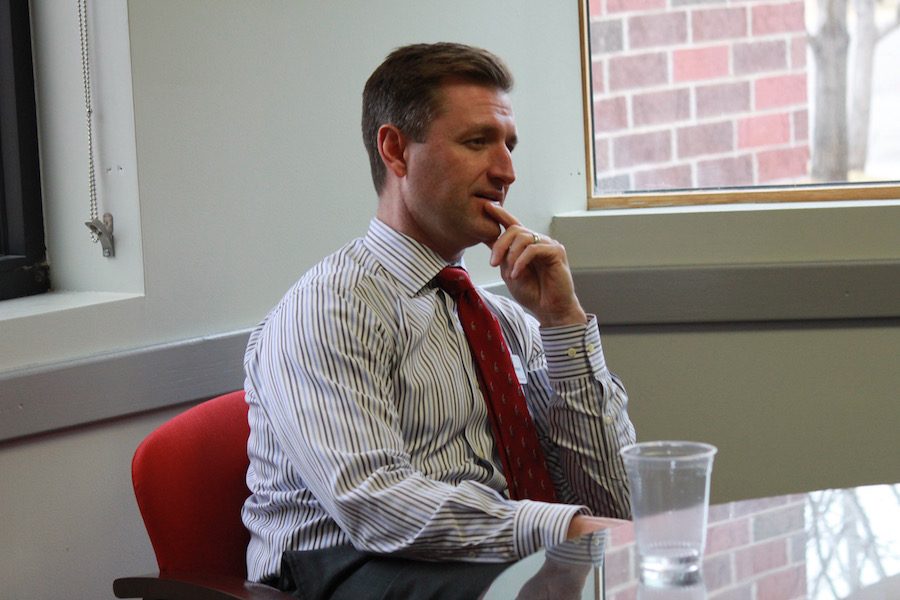Q&A with President Dr. Ehrmantraut
Dr. Adam Ehrmantraut is the new President of BSM. What plans does he have for the school’s future?
Dr. Adam Ehrmantraut returned to BSM this February as the new school President. He sat down with the Knight Errant to discuss the future of BSM.
Knight Errant: Could you share with us a bit about your time as a teacher at BSM?
Dr. Adam Ehrmantraut: I started teaching here in 1999, and I was a social studies and a business teacher for seven years. Some of my colleagues at that point in time are still here, so it’s fun to come back and see them. I also coached JV hockey for the boys here [and] took students on a few mission trips to El Salvador and Guatemala; I was the Youth in Government Adviser. Mr. Pauly was here, Sister Jeanne was here, [and] Ms. Kern was here. It’s fun to come back and see the people you worked with over a decade ago.
KE: How has BSM been so far?
AE: It’s been wonderful; honestly, I couldn’t have asked for more. It’s a great feeling coming back to a school you believe in so deeply. That’s really what it’s felt like, reconnecting with former students and former parents, and in some cases grandparents. It’s really been a gratifying position.
KE: How do you plan to be involved in the BSM community?
AE: That’s a big question. Within the school, one of the key pieces will be being visible and being open to students, faculty, and staff and being really intentional about connecting with as many people as I can. You also do the same thing with people who are connected to the school, working with, for example, the alumni office, still connecting with Red Knights after they leave and that this is a place where they always feel like home. I see a combination of approaches: one, focusing on alumni: two, parents; students and staff, and also different benefactors. It’s about being present to all of those constituents over the course of time.
KE: Do you have any interesting stories?
AE: Here’s the usual answer: I don’t know yet. When somebody asks, I just say, “I don’t know yet.” I just haven’t gotten that far; when you’re only here for three or four weeks, you learn only so much. It’s not necessarily an interesting story, but I find myself saying that a lot. One of the surprising pieces has been getting a call from a student I had in class 15 years ago or a student I had in class 17 years ago. That’s really a treat; they’re all grown up, out in the world doing something. Those experiences have really been fun so far.
KE: What is your faith life like?
AE: [I have] three kids and a wife; we’re Catholics, and my kids are Catholic students. That’s the beautiful piece of working at a Catholic school, I get to live it on a public matter on a day-to-day basis. It’s more tricky in public settings rather than private settings. That’s been a fantastic part of returning to BSM. We’re parishioners at Nativity Church in Saint Paul.
KE: Do you have a vision for the future of BSM?
AE: There are some trends that are going to impact BSM more significantly over time. We think about educational programming, time’s a variable that can be more flexible. People learn more than just in the walls of a school; they learn all over the place. We’ll probably adjust and acknowledge the variability of the barriers of time. We will also probably address more real-world learning. How do we acknowledge that a student may be learning about an economic principle through their internship over the summer at a specific firm downtown? How do we acknowledge that real-world learning in a school context? I think we’ll get down that path, and we’ll see greater degrees of partnerships between BSM and external organizations. That could be businesses, that could be nonprofit, it could be anything, but we will see more of that in the future as well. We already do this, but we’ll continue to see more emphasis on more than content mastery, but also skill-based mastery and attitudes that are going to be essential to our students in the next hundred years.
KE: How do you plan to balance the liberal arts and STEM classes?
AE: Based on our graduation requirements, students have a great opportunity to dig into several different disciplines. I think we have the framework there, it’s just [about] staying solid and consistent with that framework over time.
KE: What is your favorite part about this new job?
AE: I think having the opportunity to participate in a wide variety of the school’s operations and being connected to so many people associated with this school on a multitude of levels is what’s the most interesting to me. Another part I love is seeing what our students do, getting to hear stories about current students and former grads and how they’re impacting the world. That’s incredible; I love that.
KE: How do you plan to enhance the BSM community?
AE: I think the mission and the bones here are strong, to me it’s a matter of staying the course to our mission. That’s how you ensure a school continues to thrive, and students continue to impact the world after they leave. All of our programming, our financing, everything is built around that mission.






































![Teacher Lore: Mr. Hillman [Podcast]](https://bsmknighterrant.org/wp-content/uploads/2025/03/teacherlorelogo-1200x685.png)




